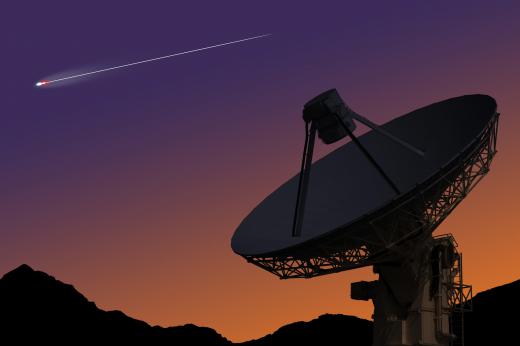What are Some Known Extrasolar Planets?
 Michael Anissimov
Michael Anissimov
An extrasolar planet, or exoplanet, is a planet in a solar system other than our own. We've always supposed that they existed, but it wasn't until 1992 that the presence of an extrasolar planet was definitively confirmed. Another discovery was made slightly earlier, in 1988, but it wouldn't be confirmed until 2003. The 1992 discovery, which was by radio astronomers Aleksander Wolszczan and Dale Frail, uncovered a planetary system around the fast-rotating pulsar PSR 1257+12. These unusual planets are thought to have either formed from the remnants of the supernova explosion that created the pulsar, or else be the rocky cores of gas giants whose atmospheres were stripped off by the supernova.
Another major milestone in the astronomy of extrasolar planets came on 6 October 1995, when Michel Mayor and Didier Queloz of the University of Geneva announced that they had discovered an extrasolar planet orbiting a main sequence (Sun-like star), 51 Pegasi, approximately 50 light-years away. The planet was discovered using the radial velocity method, which uses a sensitive spectroscope to detect regular velocity changes in a star's spectral lines with magnitudes as small as 70 meters per second. The planet was named 51 Pegasi b, a naming convention used for all extrasolar planets. The first extrasolar planet orbiting a star is designated "b," the second "c," the third "d," and so on.

51 Pegasi b was an interesting example of an extrasolar planet because it was very massive, about half the mass of Jupiter -- about 150 times that of the Earth -- but it orbits extremely close to its home star, just 0.05 AU, about on-eighth small than the distance between Mercury and the Sun. 51 Pegasi b orbits its home star every four days. This discovery forced astronomers to recognize that such a planet -- massive and with a small orbit -- could exist. Before that, it was thought that massive planets formed farther out in solar systems, as we observe in our own.

This class of planets became known as "Hot Jupiters" because of their great heat and mass. In subsequent years, many other Hot Jupiters have been discovered, forcing scientists to study how so many planets could engage in orbital migration -- forming in the outer reaches of the stellar system, then migrating inwards. The question is still not completely answered.
Another class of discovered extrasolar planets are known as Super-Earths. Because of the sensitivity of our current detection methods, these are the smallest extrasolar planets we've discovered -- planets with between 2 and 10 Earth masses (though the definition varies). The first two exoplanets discovered, PSR B1257+12 b and PSR B1257+12 c, are Super-Earths, each with a mass about 4 times greater than the Earth. Several other Super-Earths have been discovered since. The most notable is Gliese 581 c, discovered in April 2007 by a team headed by Stephane Udry based in Switzerland.
This was the first Super-Earth to be discovered in the star's habitable zone, meaning its surface temperature is likely between 0 and 40 degrees Celsius, without taking into consideration any possible atmosphere. This is the first extrasolar planet discovered that could be habitable to humans, and it won't be the last.
AS FEATURED ON:
AS FEATURED ON:












Discuss this Article
Post your comments